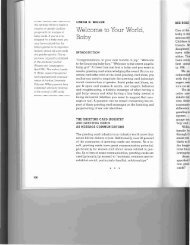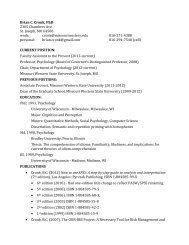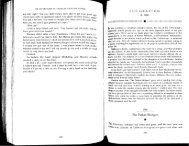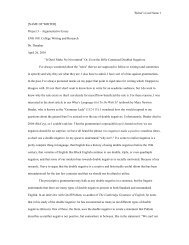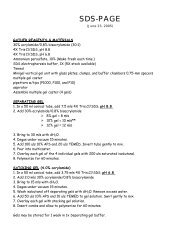Millikan Oil Drop
Millikan Oil Drop
Millikan Oil Drop
You also want an ePaper? Increase the reach of your titles
YUMPU automatically turns print PDFs into web optimized ePapers that Google loves.
In our experiments, a modified version of <strong>Millikan</strong>’s apparatus is used. An<br />
atomizer produces a large number of oil droplets between the plates. By selective<br />
application of an electric field, one droplet is singled out for observation. The droplets<br />
are contained in a glass-walled compartment, with horizontal plates only about 3 mm<br />
apart and applied voltages in the 100 to 350-volt range. Fields lower than <strong>Millikan</strong>’s are<br />
used since the droplets are also smaller than his. The droplets are observed with a highpower<br />
microscope and a high-sensitivity closed-circuit television system.<br />
Theory:<br />
(I) Measurement of the mass and radius of the droplet.<br />
Consider a spherical drop of density ρ and radius a falling under gravity in air of<br />
density σ. Stokes’ law states that for a spherical body falling with velocity v in a<br />
medium of viscosity η, the viscous resistive force is given by 6πηav. The<br />
Archimedean upward force on the body will be 4πa 3 σg/3. If the falling body has<br />
reached its terminal velocity v and is therefore no longer accelerating, then the<br />
weight of the body must equal the upward force plus the viscous force.<br />
Therefore,<br />
3 3<br />
4πa ρg 4πa σg<br />
= 6πηav<br />
+<br />
3 3<br />
weight viscous upward force<br />
of drop force due to air<br />
4 3<br />
and ( ) 6<br />
3 π a ρ − σ g = πηav<br />
.<br />
Typically, σ is close to ρ/1000 and therefore, within the accuracy of this<br />
4 3<br />
experiment, can be ignored. Then 6<br />
3 π a ρ g = πηav<br />
and 9η<br />
v<br />
a = .<br />
2ρ<br />
g<br />
(II) Static Experiment<br />
If an electric field E is now applied so that the drop, if charged, remains<br />
suspended between the two plates, then the weight of the drop will be balanced by<br />
the upward electric force. Thus if e’ is the total charge on the drop, then<br />
eV '<br />
mg = e'<br />
E = s<br />
where V s is the voltage across the plates and d is the plate<br />
d<br />
mgd ⎛4<br />
3 ⎞ d<br />
separation, and e'<br />
= , or e'<br />
= ⎜ πa ρ ⎟ g . Substituting in our equation above<br />
V<br />
⎝ ⎠ V<br />
to eliminate a we get<br />
s<br />
3<br />
s<br />
1/2<br />
⎧⎪<br />
⎛ 9η<br />
⎞ ⎫⎪v<br />
Kv<br />
e' = ⎨6πµ<br />
d⎜<br />
⎟ ⎬ =<br />
⎪⎩<br />
⎝ ρ g ⎠ ⎪⎭<br />
V V<br />
3/2 3/2<br />
2<br />
s s<br />
where K is the constant within the brackets.<br />
(III) Dynamic Experiment<br />
If the applied voltage is increased above V s , the droplet will rise in this applied<br />
field. If V is now the applied voltage, and the droplet has reached its terminal<br />
velocity, then<br />
3 3<br />
4 π a ρ g eV ' 4 a g<br />
+ 6πηav2<br />
= +<br />
π σ<br />
3 d 3<br />
weight viscous electric upward force<br />
of drop force field force due to air<br />
Solving this for e’, as for the static case, gives the equation:<br />
,



